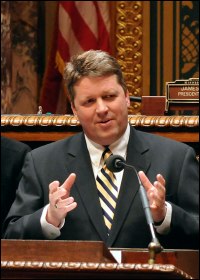Alternative Teacher Licensure
This past Tuesday, the Education committee in the Minnesota Senate passed an alternative Teacher licensure bill. I voted against that bill.
At a time when discussions have focused on increased rigor, teacher quality, and closing the achievement gap, fast tracking teacher licensure doesn’t see make sense. Senate File 2757 would allow person with a BA who has passed reading, writing, and math exams and a 5 week preparation course to be in charge of a classroom.
How can an individual, who has not adequately demonstrated proven success in an actual classroom setting experience, do a better job in closing the achievement gap? Hundreds of laid off teachers and recent college graduates from 4 year teacher preparation programs are already looking for work. There are sufficient high quality experienced teachers for most subjects.
The current system allows for flexibility. There are certain organizations such as “Teach for America” that already have programs in place in Minneapolis, St. Paul, and Brooklyn Center having been granted waivers by the Board of Teaching. That program could continue.
Minnesota has long been a leader in quality education. We consistently lead the nation in ACT scores and high school graduation rates. Some argue that an alternative teacher licensure option in Minnesota will increase our chance for success in the Federal “Race to the Top” initiative. Federal oversight, (think No Child Left Behind) should not be the carrot for teacher quality in this state. Let’s do all we can to ensure that our current 70,000 educators are the best they can be.

 My brother Andy was born in 1977. In many ways, it was a sad day in our household. When he died nearly 20 years later, an entire community mourned.
My brother Andy was born in 1977. In many ways, it was a sad day in our household. When he died nearly 20 years later, an entire community mourned. Not surprisingly, several of our Minnesota schools are struggling with the issue of declining enrollment. One of the largest school districts in the state, the Anoka-Hennepin district, has lost 2000 students in the past five years and after a 5-1 vote by the school board Monday night; the district will be closing eight schools. While school finance can be a complicated subject, one aspect of it can be summarized rather simply – fewer students mean fewer dollars in the operating budgets of school districts. While the larger school districts make the choice to close schools or cut staff, smaller districts wrestle with smaller class sizes to the point that efficiency is lost and grade sharing and reorganization with other school districts become critical to long term survival. None of these changes is easy work.
Not surprisingly, several of our Minnesota schools are struggling with the issue of declining enrollment. One of the largest school districts in the state, the Anoka-Hennepin district, has lost 2000 students in the past five years and after a 5-1 vote by the school board Monday night; the district will be closing eight schools. While school finance can be a complicated subject, one aspect of it can be summarized rather simply – fewer students mean fewer dollars in the operating budgets of school districts. While the larger school districts make the choice to close schools or cut staff, smaller districts wrestle with smaller class sizes to the point that efficiency is lost and grade sharing and reorganization with other school districts become critical to long term survival. None of these changes is easy work. Even though the election is over a year away, the race for Governor is in full swing. I have had several calls from candidates and have enjoyed lunch or a cup of coffee with a numerous others, looking for support. Politicians from both parties have declared their candidacy, started exploratory campaigns, or are still considering a run for the right to succeed Tim Pawlenty as Minnesota’s 40th Governor.
Even though the election is over a year away, the race for Governor is in full swing. I have had several calls from candidates and have enjoyed lunch or a cup of coffee with a numerous others, looking for support. Politicians from both parties have declared their candidacy, started exploratory campaigns, or are still considering a run for the right to succeed Tim Pawlenty as Minnesota’s 40th Governor.
